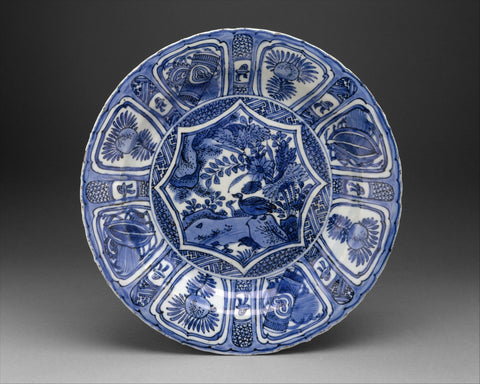If you would like to view authentic kraak porcelain in Singapore, head over to the Asian Civilisations Museum.
17th century Europe was gripped by an addiction to kraak. *excuse the pun*
The addiction caused wars between nations and swayed government policies.
What on earth is kraak?
kraakware is a type of early Chinese export blue-and-white porcelain made especially for the European market.
Kraak's distinctive feature is the way the design is laid out on the dish. The dishes feature a central medallion painted with a naturalistic scene with divided panels on the lip.
The small panels on the lip are filled in with Chinese motifs often symbols of good fortune like peaches, lotus, or plum blossoms.
This design 'template' enabled Chinese manufacturers to produce kraak by the tens of thousands.

You'll also see them featured in numerous Old Masters' still life paintings:

Isaac van Duynen. Oil on canvas. 1660s. Grapes, peaches and plums in a 'wan-li kraak' porcelain dish and in a wicker basket, a pewter jug and a silver plate, all on a partially draped table in an interior.
Chinese export porcelain caused a sensation when they arrived in Europe in the 17th century thanks to the capture of a Portuguese merchant ship named Santa Catarina by the Dutch in 1603.
The ship was carrying thousands of pieces of Chinese porcelain in its cargo which the Dutch sold at public auction. The total value of sales from that first auction alone was three million Dutch guilders which opened the eyes of Dutch merchants to the profitability of Chinese porcelain.
In fact, the story of the Santa Catarina, is one that changed the course of global trade and international law.
The incident which took place on February 25th, 1603 off the coast of Singapore, sparked Hugo Grotius, a young lawyer hired by the Dutch East India Company to justify its action - considered to be an act of piracy at the time - to pen an expansive treatise provisionally entitled De Indis (On the Indies). This piece of writing is considered today to be the cornerstone of the moral law of nations.
Piracy or not, the cargo of Santa Catarina, sparked an absolute mania for Chinese porcelain in 17th century Europe!
Fun fact:
Kraak: where the word crockery came from.

